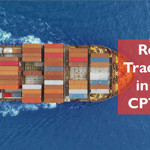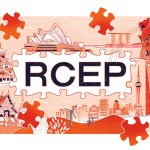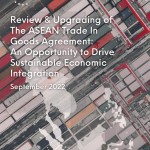Total number of posts 36.
 This report is an outcome of ERIA’s quantitative assessment of the impact of the ASEAN Trade in Goods Agreement (ATIGA) on intra-ASEAN trade. The study was conducted according to the mandate given by the ASEAN Coordinating Committee on ATIGA (CCA) and with support from the ASEAN Member States, who shared relevant trade and tariff data. The assessment of the performance of ATIGA is conducted through a descriptive analysis of tariff liberalisation; an examination of the margin of preference (MOP) between ATIGA and Most Favoured Nation (MFN) tariffs and the ATIGA utilisation rates; and econometric analysis using the gravity model. As a direct consequence of ATIGA, tariffs on intra-ASEAN trade have been reduced to zero for almost all tariff lines. However, only a subset of these tariff lines offers a margin of preference high enough to incentivise firms to utilise ATIGA when trading within ASEAN. Furthermore, the cost of compliance with ATIGA provisions reduces the likelihood of utilisation when MOP is low. For these reasons, the impact of ATIGA is limited to certain sectors and products where MOP remains high (due to high MFN tariffs). Moreover, assessing the effectiveness of ATIGA by examining the relative growth of overall intra-ASEAN trade would be misleading due to the reliance of AMS on imports from non-AMS, especially China and Japan, to produce their imports, and the availability of many other preferences such as the ASEAN Plus One FTAs.
This report is an outcome of ERIA’s quantitative assessment of the impact of the ASEAN Trade in Goods Agreement (ATIGA) on intra-ASEAN trade. The study was conducted according to the mandate given by the ASEAN Coordinating Committee on ATIGA (CCA) and with support from the ASEAN Member States, who shared relevant trade and tariff data. The assessment of the performance of ATIGA is conducted through a descriptive analysis of tariff liberalisation; an examination of the margin of preference (MOP) between ATIGA and Most Favoured Nation (MFN) tariffs and the ATIGA utilisation rates; and econometric analysis using the gravity model. As a direct consequence of ATIGA, tariffs on intra-ASEAN trade have been reduced to zero for almost all tariff lines. However, only a subset of these tariff lines offers a margin of preference high enough to incentivise firms to utilise ATIGA when trading within ASEAN. Furthermore, the cost of compliance with ATIGA provisions reduces the likelihood of utilisation when MOP is low. For these reasons, the impact of ATIGA is limited to certain sectors and products where MOP remains high (due to high MFN tariffs). Moreover, assessing the effectiveness of ATIGA by examining the relative growth of overall intra-ASEAN trade would be misleading due to the reliance of AMS on imports from non-AMS, especially China and Japan, to produce their imports, and the availability of many other preferences such as the ASEAN Plus One FTAs.
Our quantitative analysis finds that the utilisation rate of ATIGA, which is defined as the percentage of imports under ATIGA preference out of total imports of products that have positive MOP, is increasing for those products and sectors where MFN tariffs remain high. These include the agriculture and automotive sectors. The gravity estimates done at the (HS 3-digit) product level show that only a handful of products have positive coefficient on ATIGA, indicating a trade creation effect of ATIGA in only a few sectors. However, the trade creation effect is larger for products where the utilisation rates of ATIGA are greater due to a higher MOP. The larger priority integration sectors (PIS) where ATIGA utilisation has increased markedly include agriculture, processed agriculture, and automotive.
As AMS further liberalise their economies unilaterally and as new multilateral agreements (e.g. the Regional Comprehensive Economic Partnership, RCEP) come into force, ATIGA needs to be updated to remain relevant. The key focus of reform should be on reducing the cost of compliance by, amongst other things, revamping the rules of origin or procedures for issuance of the certificates of origin. This would ensure that even small margins offered by ATIGA continue to be valuable to traders. Furthermore, the sectors where ATIGA is most effective due to high MOP are those where small and medium-sized enterprises (SME) are involved. So, ATIGA can continue to be an important driver of SME engagement in intra-ASEAN trade. But to ensure ATIGA’s success in doing so, specific information on barriers to utilisation of ATIGA by these firms needs to be collected and underlying issues need to be addressed.
Report is available for download here.














